Reviewing the 3D Model
On this page :
- Introduction
- Three ways to review the 3D model
- Tips for visually examining the 3D model
- Searches for specific member review windows
- Using reports to review the 3D model
An SDS2 review station lets you double-check the SDS2 3D model in your current Job to confirm that a full-featured SDS2 program has designed connections in that Job to your liking.
The framing situation checking that a full-featured SDS2 program performs during Process and Create Solids is designed to handle most cases of beam-to-beam and beam-to-column connections and will prevent material interferences for these connections while at the same time ensuring that connections are correctly designed per the selected " Connection design method ." Framing checking does little with vertical and horizontal braces since the possible combinations are so numerous.
Consequently, there are always going to be situations where the user must exercise his/her judgment in evaluating multiple interacting connections. That is why performing searches and visually inspecting the 3D model is so important.
Three ways to review the 3D model :
Visual inspection: One way to review how a full-featured SDS2 program has designed connections is to enter Modeling to view the 3D model in solids form. Visually examining the 3D model in Modeling is an excellent way to catch glaring errors as well as to see subtleties of design that would otherwise be difficult to visualize. For more information, see Tips for visually examining the 3D model .
Specification review: Much information about the 3D model can be obtained from various specification windows. For example, the Model > Member > Member Review command can be used to access individual beam , column , vertical brace or horizontal brace review windows in order to evaluate how the program has designed connections. This program also lets you access individual member review windows by performing Searches for members with, for instance, failed connections or indeterminate ends . On the list of member piecemarks that appears when you do a search, you can click on any member listed, and this program will immediately open the review window for that member. The most detailed of connection specifications are reviewed using the connection design locks that may be found on member review windows. For more information, see Searches for specific member review windows .
Generate reports : Many of the reports that you can generate in this program are compiled from 3D model. Reports can therefore assist you in the review of specifications.. For more information, see using reports to review the 3D model .
Tips for visually examining the 3D model :
Navigating through the model: Open ( Ctrl + o ) lets you switch from view to view while you are in Modeling . Zoom In to Region or Snap to Surface can be used to get a closer look at items in a view. If your mouse is equipped with a mouse wheel , you can wheel in to zoom in, wheel out to zoom out. If you are on the surface of a member and want to step back to your previous view, Undo View Change . If you are unsure whether a particular connection is correct or not, Retain View to save a zoomed-in view of that connection so that you can return to it later.
An excellent way to check connections is to invoke Snap to Surface , left-click ( Locate ) on the top flange of the beam whose connections you want to look at, use your middle mouse button to Pan over to above the connection, then lower the elevation so that your perspective is from underneath the beam flange.
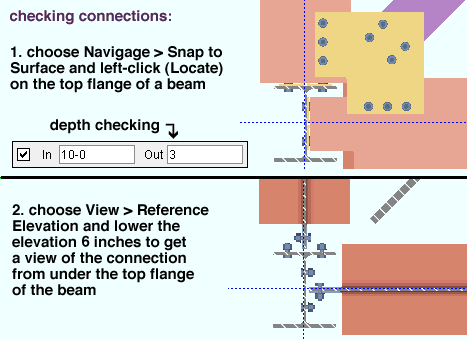
Doing a Clash Report ( Reports > Clash Report ) can identify any materials in a particular erection view that overlap as much or more than a specific tolerance that you specify. The area where the two materials "clash" will be circled by the program as shown below:
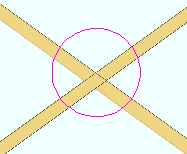
Reviewing the 3D model is easiest in an isometric view , as this type of view allows you to see more surfaces than you would be able to see in a plan view or elevation view . Shown below is an isometric view of model displayed in solids form:
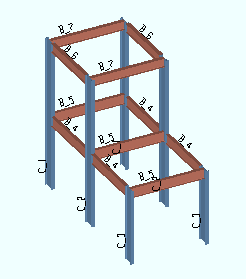
Status can help you to narrow your search for items such as members with failed connections . Choose Model > Status Display (
) to set status display options. In the example below, Status Display was used to display W16x31 member section sizes in the color cyan:
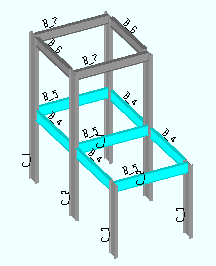
Find Material mode lets you easily locate material by its submaterial mark . To get into Find Material mode, choose Model > Material > Find Material . All members containing the material whose submaterial mark you select will be isolated from other members in your current view. The submaterial specified will be displayed in cyan, and the rest of the member will be its normal color. In the example below, the submaterial specified is an angle:
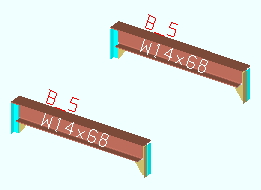
Isolating a single member lets you quickly double check all submaterials associated with that member. Choose Model > Member > Isolate Member to isolate a member so that all submaterials of that member are separate from the rest of the 3D model.
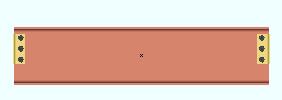
Searches for specific member review windows :
Searches can help you to make sure that a full-featured SDS2 program has designed all system connections the way you want them to be designed. These searches may be done in Modeling or the Drawing Editor by choosing Process > Search . Some of these searches are listed below:
Failed Connections - a search for members for which the program was unable to design a system connection that would stand up to the specified or calculated load. On the beam , column , vertical brace or horizontal brace review window for that member, you will find a connection failure message such as that shown below. Beam , column , horizontal brace and vertical brace connection failure messages can give you clues about steps you can take to generate a connection that will not fail.
![]()
Connections Below Minimum Setup - a search for beams on which the number of bolt rows are less than the minimum number of bolt rows that are specified under Job Options in the Structural Members Schedule of Minimums for a beam with that particular nominal depth. The program also will look for welds that are less than the Home > Project Settings > Job > Design > Weld Design Settings > " Minimum weld size for this job ."
Bolt Diameters Changed by System - a search for members with connections whose bolt diameters have been increased by connection design in order to create a system connection that will stand up to the specified or calculated loading conditions.
Indeterminate Ends - a search for members with ends that do not frame into anything (plain ends). When you go to the member review window ( Beam Review window or Column Review window or Horizontal Brace Review window or Vertical Brace Review window or etc.) for a particular member that has been found in this search, you will find that the field " System designed connection " for at least one end of the member will read ' Plain end '.
Using reports to review the 3D model :
For engineering review, the most important report you can output are the Connection Design Calculations Report or Expanded Connection Design Calculations Report . The reports include technical specifications about the design of particular members and their connections.
The Check Report summarizes key specifications contained on member review windows
The Joist Report serves as a bill of material for ordering joists.
An ABM report summarizes material ordering information based on the 3D model.
A Shape File Report is not derived from the 3D model, but is a description of the specifications of materials that can be added to the 3D model. This report can list particular material types that you select from a particular shape file. The shape file that is used for a Job directly affects many physical properties of the materials in that Job.
For more information, see Reports .